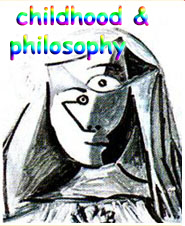on the relevance of cognitive neuroscience for community of inquiry
DOI:
https://doi.org/10.12957/childphilo.2019.37513Keywords:
community of inquiry, cognitive psychology, reason and emotionAbstract
Community of inquiry is most often seen as a dialogical procedure for the cooperative development of reasonable approaches to knowledge and meaning. This reflects a deep commitment to normatively based reasoning that is pervasive in a wide range of approaches to critical thinking and argument, where the underlying theory of reasoning is logic driven, whether formal or informal. The commitment to normative reasoning is deeply historical reflecting the fundamental distinction between reason and emotion. Despite the deep roots of the distinction and its canonization in current educational thought, contemporary cognitive neuroscience presents a fundamental challenge to the viability of the distinction and thus to any effort that sees education for reasonable judgment to be based on the remediation of cognition in isolation from its roots in the emotions. Cognitive neuroscience looks at the deep connections between emotion and memory, information retrieval, and resistance to refutation. This conforms with earlier studies in experimental psychology, which showed resistance to changing beliefs in the face of evidence, including evidence based on personal experience. This paper will look at the recent research including speculations from neurological modeling that shows the depth of connection between, emotions, memory and reasoning. It will draw implications for dialogic thinking within a community of inquiry including systematic self-reflection as an essential aspect of critical thinking.
Downloads
References
Amodio, D.M., & Devine, P.G. (2006). Stereotyping and evaluation in implicit race bias: Evidence for independent constructs and unique effects on behavior. Journal of Personality and Social Psychology, 91, 652-661. doi:10.1037/0022-3514.91.4.65233
Blair, I.V., Ma, J.E., & Lenton, A.P. (2001). Imagining stereotypes away: The moderation of implicit stereotypes through mental imagery. Journal of Personality and Social Psychology, 81, 828-841.
Bloom, B. S., Engelhart, M. D., Furst, E. J. Hill, W., Krathwahl, D. (1956). Taxonomy of educational objectives: The classification of educational goals. New York: David McKay Company.
Bremer, Manuel (2005). An introduction to paraconsistent logics. Frankfurt: Peter Lang.
Chalmers, D. (1996). The conscious mind. New York: Oxford University Press.
Chomsky, N. (1957). Syntactic structures. The Hague: Mouton.
Damasio, A. (1995). Descartes’ error: emotion, reason and the human brain. New York: Harper.
Damasio, A. (2012). Self comes to mind: Constructing the conscious brain. Random House, LLC.
Dunham, Y., Baron, A.S., & Banaji, M.R. (2008). The development of implicit intergroup cognition. Trends in Cognitive Sciences, 12, 248-253. doi:10.1016/j.tics.208.04.006
Dovidio, J.F., & Gaertner, S.L. (2005). Color blind or just plain blind? The pernicious nature of contemporary racism. The Nonprofit Quarterly, 12, 40-46.
Eiser, J. R. (1987). Attitudinal Judgment. New York: Springer-Verlag.
Evans, J. (2008). Dual-processing accounts of reasoning, judgment, and social cognition. Annual Review of Psychology, 59, 255-278.
Gardner, H. (1987). The mind’s new science. New York: Basic Books.
Greenwald, A.G. & Krieger, L.H. (2006). Implicit bias: Scientific foundations. California Law Review. 94, 945-967.
Gutsell, J.N. & Inzlicht, M. (2010). Empathy constrained: Prejudice predicts reduced mental simulation of actions during observation of outgroups. Journal of Experimental Social Psychology. 46, 841-845.
Hamilton. D. J. (ed.). (1981). Cognitive Processes in Stereotyping and Intergroup Behavior. Hillsdale, NJ: Erlbaum.
Iacoboni, M., Molnar-Szakacs, I., Gallese, V., Buccino, G., Mazziotta, J.C., & Rizzolatti, G. (2005). Grasping the intentions of others with one’s own mirror neuron system. PLoS Biology, 3, (3): e79.
Jacoby, L. L., Kelley, C. M., Brown, J., & Jaseschko, J. (1989). Becoming famous overnight: Limits on the ability to avoid unconscious influences of the past. Journal of Personality and Social Psychology, 326-338.
Kahneman, D. Slavic, P. and Tversky, A. (1982). Judgments under uncertainty:heuristics and biases. New York: Cambridge UP.
Lebrecht, S., Pierce, L.J., Tarr, M.J., & Tanaka, J.W. (2009). Perceptual other-race training reduces implicit racial bias. PLoS ONE, 4, 1-7.
Lewandowsky, S., Seifert, C., Schwarz, N., & Cook, J. (2012). Misinformation and its correction: Continued influence and successful debiasing. Psychological Science in the Public Interest, 13(3), 106-131.
Lipman, M. (1974). Harry Stottlemeier’s discovery, Upper Montclair, NJ: IAPC.
Lipman, M. (1991). Thinking in education. Cambridge: Cambridge University Press.
Nisbett and Ross, 1980. Human inference. Englewood Cliffs, NJ: Prentice Hall.
Paul, R. (1990). Critical Thinking. Rohnert Park, CA: CCTMC.
Ramsey, K., & Frankish, W. M. (2012). The Cambridge handbook of cognitive science. Cambridge: Cambridge University Press.
Reznitskaya, A and Gregory, M (2013): Student thought and classroom language: Examining the mechanisms of change in dialogic teaching. Educational Psychologist, 48:2, 114-133
Rudman, L.A. (2004). Sources of implicit attitudes. Current Directions in Psychological Science. 13, 79-82.
Scerri, E. R. (2007). The Periodic table: Its story and its significance. New York: Oxford University Press.
Sharp, A. (2007). Education of the emotions in the classroom community of inquiry. Gifted Education International, 22(2-3), 248-257.
Siegel, H. (1987). Relativism refuted. Dordrecht: Reidel.
Siegel, H. (1988). Educating reason. New York: Routledge.
Thagard, P., & Aubie, B. (2008). Emotional consciousness: A neural model of how cognitive appraisal and somatic perception interact to produce qualitative experience. Consciousness and Cognition, 17(3), 811-834.
Walton, D. (1992). Slippery slope arguments. Oxford: Clarendon Press.
Walton, D. (1996). Argumentation schemes for presumptive reasoning. Mahwah, NJ: Erlbaum.
Wason, P. and Johnson-Laird, P. (1972). The psychology of reasoning: Cambridge, MA: Harvard UP.
Weinstein, M. (1994). The psycho-logic of race prejudice. Analytic Teaching, 14:2.
Weinstein, M. (2002). Exemplifying an internal realist theory of truth.
Philosophica, 69:2002(1), 11-40.
Weinstein, M. (2011). Arguing towards truth: The case of the periodic table. Argumentation, 25(2), 185-197.
Weinstein, M. (2013). Logic, truth and inquiry. London: College Publications
Weinstein, M. (2015). Cognitive science and the model of emerging truth. In Garssen, B. Godden, D., Mitchell, G. & Snoeck Henkemans, A. (eds). Proceedings of the 8th International ISSA Conference, ISSA, 2015.




